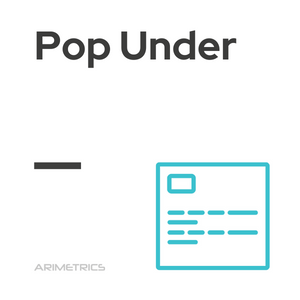 Definition:
Definition:
A pop-under is a type of digital advertisement that appears in a separate browser window, located behind the page the user is viewing. Unlike pop-ups, which open above the current window and can interrupt the user’s experience, pop-unders remain hidden until the user closes or minimizes the main browser window. This approach makes them less intrusive, as they do not distract the user from their current activity. However, due to their hidden nature, pop-unders can be perceived negatively, as some users associate them with invasive practices or malicious software.
Advantages and disadvantages of pop-under
This type of ad has its pros and cons. Here are the advantages and disadvantages of using pop-unders in digital advertising.
Advantages
Among the advantages of using pop-under we can mention:
- Less intrusive: By appearing behind the main window, the pop-under does not interrupt the user’s activity, making it a less intrusive option for digital advertising.
- Allows multitasking: Users can continue with other tasks without distractions, as the ad remains hidden until they decide to close or minimize the active window.
Inconveniences
The pop-under shows, however, some drawbacks:
- Negative association: Pop-unders are often associated with the idea of viruses or malware, which can damage the perception of the website that uses them.
- Difficult to measure effectiveness: It is difficult to determine how effective a pop-under is to promote a product or brand, since users may close it without interacting with it.
- Browser blocking: Many browsers and extensions have features to block pop-ups, including pop-unders, which reduces the likelihood that users will see the advertisement.
- Platform restrictions: Google and other browsers consider pop-unders to worsen the user experience and therefore block or prohibit them.
Examples of pop-under usage
Despite criticism, pop-unders have been used in a variety of contexts. Here are some examples of their application:
- Product or service promotions: Companies that wish to capture the user’s attention after the end of their main activity in the browser.
- Special offers: Show discounts or promotions that might be of interest to the user after the end of their browsing session.
- Lead generation: Subscription forms that appear when closing the main window, in order to capture contact information.
Alternatives to pop-under
Because of the limitations of pop-unders, many companies are looking for more effective options. Some alternatives are explored here:
- Controlled pop-ups: Pop-ups that appear at strategic times, such as when the user is about to leave the site, but are less intrusive and offer clear value.
- Native banners and ads: Integrate advertising directly into site content, so that it feels natural and relevant to the user.
- Push notifications: Messages that are sent to the user’s device with their consent, providing updates or promotions.
- Interactive content: Offer interactive experiences that engage the user, such as quizzes or surveys, which can capture their attention in a more positive way.
